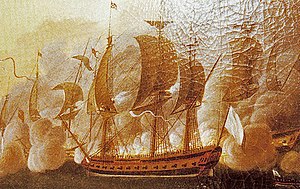French frigate Hermione (1779)
This article needs additional citations for verification. (June 2015) |
 Hermione in the Naval battle of Louisbourg, by Auguste-Louis de Rossel de Cercy
| |
| History | |
|---|---|
| Name | Hermione |
| Builder | Rochefort[1] |
| Laid down | March 1778[1] |
| Launched | 28 April 1779[1] |
| In service | June 1779[1] |
| Fate | Ran aground and wrecked due to a navigation error of her pilot at Le Croisic on 20 September 1793[1] |
| General characteristics | |
| Class and type | Template:Sclass- 12-pounder frigate |
| Tons burthen | 550 tons; 1160 ton burthen[1] |
| Length | 44.2 m (145 ft)[1] |
| Beam | 11.24 m (36.9 ft)[1] |
| Draught | 5.78 m (19.0 ft)[1] |
| Complement | 255 |
| Armament |
|
Hermione was a 12-pounder Template:Sclass- of the French Navy. She became famous when she ferried General Lafayette to the United States in 1780 for support to the Americans in the American Revolutionary War. She grounded and was wrecked in 1793.
In 1997, construction of a replica ship started in Rochefort, Charente-Maritime, France; the new ship is likewise named Hermione.
Career

Hermione was built in eleven months at Rochefort, by the shipwright Henri Chevillard as a light frigate, fast and maneuverable. Between May and December 1779 she underwent successful sea trials in the Gulf of Gascony under the command of Lieutenant de Latouche.
General La Fayette embarked at Rochefort on 11 March 1780 and arrived in Boston on 28 April carrying the secret news that he had secured French reinforcements (5,500 men and five frigates) for George Washington. After the dramatic failure of the Penobscot Expedition, a large military expedition to dislodge the British from their new stronghold at the confluence of the Bagaduce and the Penobscot River on the east bank of Penobscot Bay in Maine (an area later known as Castine), the revolutionary council of Massachusetts asked Latouche if he would be willing to sail to Penobscot Bay for a quick military intelligence-gathering cruise, checking on the strength of the British garrison at Fort George. Hermione then made the week-long voyage in mid-May, after which the frigate sailed to Rhode Island.[2] Next, she got underway again on 2 June and suffered serious damage in the fierce but indecisive Action of 7 June 1780 against the 32-gun HMS Iris, under James Hawker.
Hermione received the American Congress on board in May 1781. She fought several times in company with Astrée, commanded by Lapérouse, especially at the Naval battle of Louisbourg on 21 July 1781.
After the end of the American Revolutionary War, Hermione returned to France in February 1782. She then formed part of a squadron sent to India to help Suffren against the British. However, peace was declared and the ship returned to Rochefort in April 1784.
Fate
Again in service against the British, on 20 September 1793,[3] she ran aground off Le Croisic, and was then wrecked by heavy seas. The court-martial consecutive to the wreck found her pilot, Guillaume Guillemin du Conquet, responsible for her loss; her commanding officer, Captain Martin, was honourably acquitted.[1]
Reconstruction
In 1997 a reconstruction project started in Rochefort. The new ship is named L'Hermione.
On 18 April 2015, the full-size replica of Hermione started a return voyage to the United States from Rochefort, France.[4][5] In June 2015 the frigate arrived safely on the American coast.[6]
References
- ^ a b c d e f g h i j k l Roche, p.241
- ^ Samuel Cooper, letter 23 May 1780, in Papers of John Adams, Vol.9
- ^ Troude, vol.2, p.290
- ^ "Hermione 2015". www.hermione2015.com. Retrieved 2017-07-27.
- ^ "Accueil EN" (in French). Retrieved 2017-07-27.
- ^ Yuhas, Alan (2015-06-05). "Replica French ship arrives in Virginia to hero's welcome – again, 235 years later". The Guardian. ISSN 0261-3077. Retrieved 2017-07-27.
Bibliography
- Jean-Marie Ballu, L'Hermione, l'aventure de sa reconstruction, Editions du Gerfaut, 2007 ISBN 978-2-35191-018-4
- Emmanuel de Fontainieu, Yves Gaubert, L'Hermione, de Rochefort à la gloire américaine, Editions de Monza, 2002 ISBN 978-2-908071-95-5
- Robert Kalbach, Jean-Luc Gireaud, L'Hermione, Frégate des Lumières, Dervy, 2004 ISBN 978-2-84454-319-6
- Roche, Jean-Michel (2005). Dictionnaire des bâtiments de la flotte de guerre française de Colbert à nos jours. Vol. 1. Group Retozel-Maury Millau. ISBN 978-2-9525917-0-6.
- Troude, Onésime-Joachim (1867). Batailles navales de la France (in French). Vol. 2. Challamel ainé.
- James M. Volo, Blue Water Patriots: The American Revolution Afloat, Greenwood Publishing Group, 2007 ISBN 978-0-275-98907-1
- Winfield, Rif (2007). British Warships of the Age of Sail 1714–1792: Design, Construction, Careers and Fates. Seaforth. ISBN 1-86176-295-X.
External links
This article's use of external links may not follow Wikipedia's policies or guidelines. (June 2015) |
- L’Hermione, first departure in salt water !
- L’Hermione, the great departure for America
- Website of the reconstruction project
- Naval History : l'Hermione (French)
- L'Hermione - the frigate of enlightenment
- New York Times report of reconstruction project
- The Friends of Lafayette-Hermione in America, a non-profit group, supports this reconstruction and the planned voyage.
